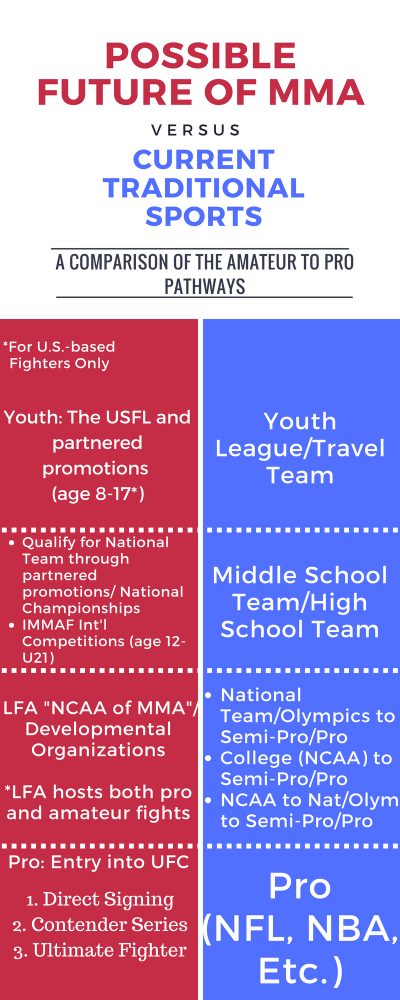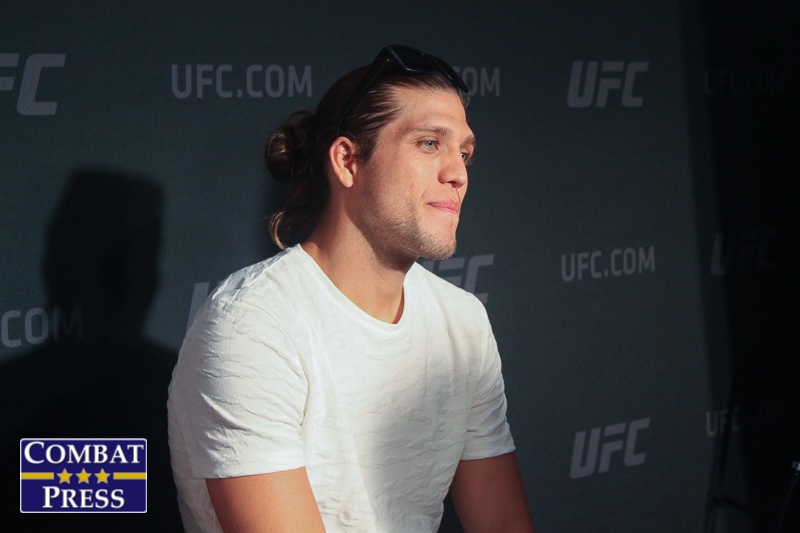[Editor’s Note: This editorial proposes a completely hypothetical scenario. The views expressed are solely those of the author. No relationship between the Legacy Fighting Alliance (LFA) and International Mixed Martial Arts Federation (IMMAF) exists at this time.]
While the sport’s popularity can fluctuate, MMA seems to be experiencing a different kind of “boom” at the moment. It’s an evolutionary boom.
The first boom came when the sport moved toward rules and regulation, the UFC was purchased by Zuffa and put back on pay-per-view, and fighters became hybrids of many styles.
The next boom occurred when Zuffa acquired Pride Fighting Championships, World Extreme Cagefighting and Strikeforce between 2007 and 2013. This period brought many big names of the time under the UFC banner.
Four other recent events have now caused the sport to enter a third evolutionary phase: the $4.025 billion purchase of the UFC by WME-IMG in 2016, the UFC joining “The Worldwide Leader in Sports” ESPN next year and two recent mergers between other organizations.
Leading developmental promotions the Resurrection Fighting Alliance and Legacy Fighting Championship announced a merger in 2016. Their goal was to become the “NCAA of MMA.” The RFA and Legacy FC had more than 130 call-ups according to a May 21 press release. As of May 27, Bloody Elbow reports there are 569 fighters in the UFC. Barring cuts, the resulting Legacy Fighting Alliance can be credited with making up over 22 percent of the UFC.
In the first three weeks of the eight-week Dana White’s Tuesday Night Contender Series, essentially the equivalent to the NBA’s Summer League, 30 LFA veterans competed last year, making up 56.6 percent of the league’s roster.
The LFA is also allowed to use the UFC’s trademarked Octagon name and design, UFC Hall of Fame member Pat Miletich serves on the AXS TV Fights broadcast team, and even former LFA matchmaker Mick Maynard is now with the UFC.
The organization requires its fighters to fulfill media obligations, the LFA logo is similar to that of the UFC, and the RFA had been sponsored by Adidas Combat Sports, which is owned by Reebok, the brand responsible for UFC’s Fight Kits. Additionally, the LFA will hold as many as 30 events this year. The UFC will hold the same number through ESPN, excluding pay-per-view events.
MMA now has its American Hockey League to the NHL.
Combat Press reported on another recent merger between the UFC-partnered amateur International Mixed Martial Arts Federation (IMMAF) and the World Mixed Martial Arts Association (WMMAA). The move was made to create a unified effort for Olympic acceptance. There are currently around 90-100 member nations post-merger.
The situation is ongoing, but a requirement of acceptance is to create a youth branch. The United States has its youth branch in the form of the United States Fight League, which allows for competitors as young as eight under age/weight appropriate guidelines. A youth system for the entire IMMAF is still developing.
“IMMAF’s Technical Committees are currently developing pre-Junior and Cadet rules for MMA competition for 12-year-olds upwards. IMMAF will host its first junior and pre-cadet competitions in 2019,” Isobel Carnwath, the IMMAF Director of Brand, Commerce and Communications, told Combat Press.
“IMMAF is also developing and rolling out its Talent and Coaches Development Pathway,” Carnwath added. “This includes work to extend the progression scheme down to younger years. It will be the role of IMMAF National Federations to implement the program on a local level through their member clubs and gyms.”
The amateur level of MMA is now gaining more structure, as UMMAF is the sanctioning partner of a number of local-level promotions and has four approved Team USA Training Centers. Olympic amateur greats like Floyd Mayweather Jr., Mike Tyson and Muhammad Ali all benefited from their experience before turning pro, and so did the entire sport of boxing. MMA is now benefiting from its amateur level as well.
While he did not fight for the UMMAF, 14-0 pro contender Brian Ortega’s experience in MMA dates back to the USFL, where he won four fights. Ortega then went on to win the RFA featherweight championship and will now compete for the same belt in the UFC on July 7.
The UFC also just signed two-time UMMAF national and IMMAF world bantamweight champion Jose Torres, who compiled an amateur record of 25-1 and was hailed as one of the greatest IMMAF competitors ever. He’s now 8-0 as a pro and 1-0 in the UFC after his finish of Jarred Brooks at UFC Fight Night 131.
Brendan Allen of the LFA is also a former UMMAF national and IMMAF world champion.
LFA officials could not be reached for comment, and Carnwath could not comment on the LFA without more knowledge. However, she could comment on her own organization.
“IMMAF is open to working relationships with all MMA organizations that promote the best practices and are furthering the development of the sport,” said Carnwath. “IMMAF has different types of working relationships with a number of different promoters and organizations, whether at an international level or through its national federations at a local level. IMMAF is certainly keen to boost the development of the amateur circuit in the USA and is planning a Pan Ams tournament for 2019.”
 Olympic prestige helps fight negative stereotypes about MMA and fighters that still exist. The perception of being an Olympian automatically conjures up images in the minds of the public of world-class athletes, as opposed to uneducated barbarians in a “human cockfight,” as John McCain famously called the UFC in the 1990s.
Olympic prestige helps fight negative stereotypes about MMA and fighters that still exist. The perception of being an Olympian automatically conjures up images in the minds of the public of world-class athletes, as opposed to uneducated barbarians in a “human cockfight,” as John McCain famously called the UFC in the 1990s.
If the LFA and IMMAF were to partner in the future, it would be a great move for the future of the entire sport. In the case of U.S. fighters, athletes can start becoming “jacks of all trades” as young children, developing for years before facing the best in the world at their level — before they even become teenagers — through IMMAF’s developing youth rules.
The result of an IMMAF-LFA partnership could one day be a pipeline of potentially thousands of Olympians (or similar prospects) to DWTNCS, one final test in front of UFC President Dana White, or to the UFC directly. This would make the rosters and events of both the LFA and UFC even more elite than they are now.
Fighters could also come in with their own followings, which brings more eyeballs to the product and creates new fans. Some fans become fighters, and the process continues.
“Through international television broadcast deals for its championships-highlights series last year, IMMAF can estimate an 80-million audience reach,” Carnwath said.
Further exposure would then continue through the LFA. The promotion is in 53 million homes in the United States alone thanks to AXS TV. This is in addition to international television deals in place with the likes of Canada’s Fight Network and others. The LFA spreading the word about Olympic MMA and vice versa would be mutually beneficial.
Andrea “KGB” Lee, Roberto “Little Fury” Sanchez and others signed to the UFC shortly after winning LFA gold. A partnership would keep the developmental system fed. The cycle would stay in motion.
In similar fashion to what happened with the professional side of MMA, the amateur level seems to be moving away from its Wild West days. Smaller events held in bars and such will probably be a part of the sport for years to come, but now budding MMA fans and fighters have a system that can lead them to the top, like in other major sports. MMA is here to stay.
Plus, who wouldn’t want to build a career from youth on up in the next UFC video game from EA Sports, like they can in Madden NFL 18’s “Longshot” story mode, see the LFA in its first game, or begin an Olympic-style amateur tournament, as in 2011’s “Legacy Mode” from Fight Night Champion?
What do you think? Share your thoughts in the comment section.

